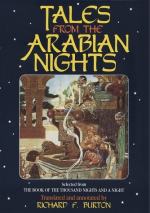[FN#215] [I read this line: “Fi Hayyi-kum Taflatun hama ’l-Fawadu bi-ha (Basit)” and translate: In your clan there is a maiden of whom my heart is enamoured. In the beginning of the next line the metre requires “tazakkarat,” which therefore refers to “Aghsun,” not to the speaker: “the branches remember (and by imitating her movements show that they remember) the time when she bent aside, and her bending, graceful beyond compare, taught me that her eyes kept watch over the rose of her cheek and knew how to protect it from him who might wish to cull it.” This little gem of a Mawwal makes me regret that so many of the snatches of poetry in this Ms. are almost hopelessly corrupted.—St.]
[FN#216] In the text “Sima’a,” lit. hearing, applied idiomatically to the ecstasy of Darwayshes when listening to esoteric poetry.
[FN#217] The birds mentioned in the text are the “Kumri” (turtle-dove), the “Shabaytar” [also called “Samaytar” and “Abu al-’Ayzar"=the father of the brisk one, a long-necked water bird of the heron kind.—St.], the Shuhrur (in Ms. Suhrur)=a blackbird [the Christians in Syria call St. Paul “Shuhrur al-Kanisah,” the blackbird of the Church, on account of his eloquence.—St.], the “Karawan,” crane or curlew (Charadrius aedicnemus) vol. vi. 1; the “Hazar;” nightingale or bird of a thousand songs, vol. v. 48; the “Hamam,” ruffed pigeon, culver, vol. v. 49; the “Kata,” or sandgrouse, vols. i. 131, iv. 111, etc.; and the “Samman” or quail, Suppl. vol. vi.
[FN#218] The “Sa’ah,” I may here remark, is the German Stunde, our old “Stound,” somewhat indefinite but meaning to the good Moslem the spaces between prayer times. The classical terms, Al-Zuha (undurn-hour, or before noon) and Maghrib=set of sun, become in Badawi speech Al-Ghaylah=siesta-time and Ghaybat al-Shams. (Doughty, index.)
[FN#219] For the beautiful song of the lute, referred to here, see vol. viii. 281.
[FN#220] Alluding to the “Takht Raml,” table of sand, geomantic table?
[FN#221] As before noted, her love enables her to deal in a somewhat of prophetic strain.
[FN#222] This scene may sound absurd; but it is admirable for its materialism. How often do youthful lovers find an all-sufficient pastime in dressing themselves up and playing the game of mutual admiration. It is well nigh worthy of that “silliest and best of love-stories”—Henrietta Temple.
[FN#223] The text bluntly says “Wa Nikah,” which can mean nothing else.
[FN#224] Scott calls him “Yiah”: vi. 354.
[FN#225] Arab. “Akhbaru-hu,” alluding to the lord Yahya.
[FN#226] Here I presume a “Kala” (quoth he) is omitted; for the next sentence seems appropriate to Yusuf.
[FN#227] In Arab. “Tastaghis"=lit. crying out “Wa Ghausah”—Ho, to my aid!
[FN#228] The “Zug” or draught which gave him rheumatism—not a romantic complaint for a young lover. See vol. ii. 9. But his power of sudden invention is somewhat enviable, and lying is to him, in Hindustani phrase, “easy as drinking water.”




